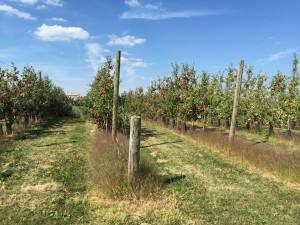Last Friday I finally made the long trek to the Cornell Orchards and it was well worth the journey. We were given a tour of the Orchards, which functions primarily as a research area and outdoor classroom, in addition to providing a venue for the public to visit and purchase apples and other local products.
It was fascinating to learn so much about the creation of new types of apples and all the work that goes into genetically evolving current varieties to design an apple with several favorable qualities. Apparently it’s necessary to graft, or attach, a specific branch to an existing one in order to ensure the production of a desired apple. These grafted stems grow to be about 12 feet tall and are supported by wiring, each tree being selectively pruned to promote a harvest with the most amount of apples possible per branch, achievable only by spacing each row correctly to allow sunlight to reach even the lowest branches. Traditional apple trees are no longer grown in these farms due to their inefficient production and space constraints. It was especially interesting to learn that when an apple seed is planted from a particular apple, the same type of apple won’t grow on the new tree. Rather, an entirely novel kind of apple will grow on that tree. The only way to perpetuate the strand is to graft it.
As someone who finds the topic of genetics captivating, it was great to have the opportunity to learn about genetics in such a new context where the ideas are actually put into practical use. It was also interesting to learn that Cornell has another off-campus apple research farm in which new apples are designed and marketed. The Empire apple, which is said to be very popular in the state of New York, was originally made by Cornell. Other varieties, such as the SnapDragon apple, which we got to pick and sample, was also a Cornell original.
I really enjoyed seeing a different aspect of Cornell and appreciating it from a new perspective. I also liked learning about a topic that superficially seems rather mundane, but actually is quite intricate and heavily planned. It makes it possible to be more aware of and marvel at the complex path that food takes to get to the average consumer, even if it’s something as simple as an apple.


That is really interesting that many new kinds of apples are made in Cornell! I always thought apple picking and growing was a simple past time with few options to choose from. Im just curious if they said anything about how they selected which apples to graft to which trees? Is there a science behind picking combinations that will be marketable or is it just luck?
The way they explained it is that basically they choose which combinations of existing apples they think will be most marketable and they try to design the new apples based on factors like taste, color, resistance to disease, and specific segments of the population they want to appeal to. So really, the options are limitless, but they have some control based on which trees they combine and what they use as pollination. I thought it was really interesting too!
I knew that Cornell grew many types of apples but I had no idea that entirely new kinds were designed here as well! This “new-era” orchard is definitely a departure from the orchards I remember visiting as a child, where there were rows of bigs trees and only a few varieties of apples. However, this change in apple-growing seems like an extremely efficient system that has the potential to both bring into existence new breeds of apples and distribute them on a large scale.